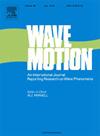Novel soliton motion with time-varying wave-width and amplitude as well as velocity through a reverse-space-time nonlocal variable-coefficient mKdV equation
IF 2.5
3区 物理与天体物理
Q2 ACOUSTICS
引用次数: 0
Abstract
Nonlocal integrable systems have received widespread attention because of their special physical effects. In this article, we present a novel reverse-space-time nonlocal variable-coefficient mKdV (RSTVmKdV) equation and reveal its N-soliton solution by Riemann–Hilbert (RH) method. We notice that the revealed soliton solutions are tilted and exhibit the following behavioral characteristics: their wave width, amplitude, and velocity vary over time. This is novel for the isospectral soliton equation. In terms of specific content, firstly, we give the Lax pair of a system of coupled mKdV equations with time-varying coefficients and construct the related solvable RH problem. Then, we analyze the symmetry of eigenvalues and . Finally, we derive the general formula for the N-soliton solution and the specific expression for single soliton solution of the RSTVmKdV equation. Through mathematical analysis and simulation, we find that when the related eigenvalues and are not conjugate, the single-soliton solution depicted is not symmetric, and when , the soliton tilts towards the negative x-axis, while when , the soliton tilts towards the positive x-axis. In addition, and affect the amplitude of solitons in the case of , while , , and affect the wave width, speed, and propagation direction of solitons. The results indicate that the method proposed in this paper can be used to derive and solve other reverse-space-time nonlocal integrable systems with time-varying coefficients and explore their rich soliton behavior.
通过逆时空非局域变系数mKdV方程求解具有时变波宽、振幅和速度的新型孤子运动
非局部可积分系统因其特殊的物理效应而受到广泛关注。本文提出了一个新颖的反时空非局部变系数 mKdV(RSTVmKdV)方程,并用黎曼-希尔伯特(RH)方法揭示了其 N 孤子解。我们注意到所揭示的孤子解是倾斜的,并表现出以下行为特征:它们的波宽、波幅和速度随时间变化。这对于等谱孤子方程来说是新颖的。在具体内容方面,我们首先给出了时变系数耦合 mKdV 方程系统的 Lax 对,并构建了相关的可解 RH 问题。然后,我们分析了特征值 η∈C+ 和 η¯∈C- 的对称性。最后,我们推导出 RSTVmKdV 方程的 N 孤子解通式和单孤子解的具体表达式。通过数学分析和仿真,我们发现当相关特征值η1和η¯1不共轭时,所描述的单孤子解不是对称的,当|η1|<|η¯1|时,孤子向负X轴倾斜,而当|η1|>|η¯1|时,孤子向正X轴倾斜。此外,在|η1|≠|η¯1|的情况下,α(t)和β(t)会影响孤子的振幅,而α(t)、β(t)和γ(t)会影响孤子的波宽、速度和传播方向。结果表明,本文提出的方法可用于推导和求解其他具有时变系数的反时空非局部可积分系统,并探索其丰富的孤子行为。
本文章由计算机程序翻译,如有差异,请以英文原文为准。
求助全文
约1分钟内获得全文
求助全文
来源期刊

Wave Motion
物理-力学
CiteScore
4.10
自引率
8.30%
发文量
118
审稿时长
3 months
期刊介绍:
Wave Motion is devoted to the cross fertilization of ideas, and to stimulating interaction between workers in various research areas in which wave propagation phenomena play a dominant role. The description and analysis of wave propagation phenomena provides a unifying thread connecting diverse areas of engineering and the physical sciences such as acoustics, optics, geophysics, seismology, electromagnetic theory, solid and fluid mechanics.
The journal publishes papers on analytical, numerical and experimental methods. Papers that address fundamentally new topics in wave phenomena or develop wave propagation methods for solving direct and inverse problems are of interest to the journal.
 求助内容:
求助内容: 应助结果提醒方式:
应助结果提醒方式:


